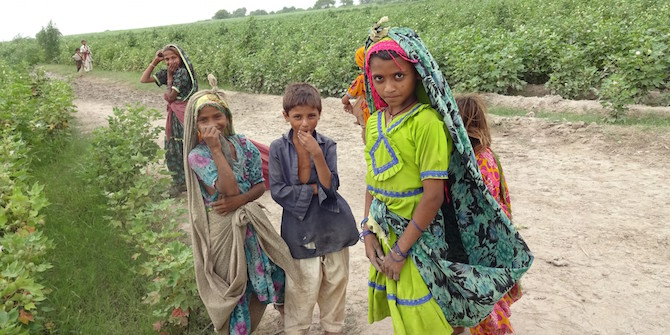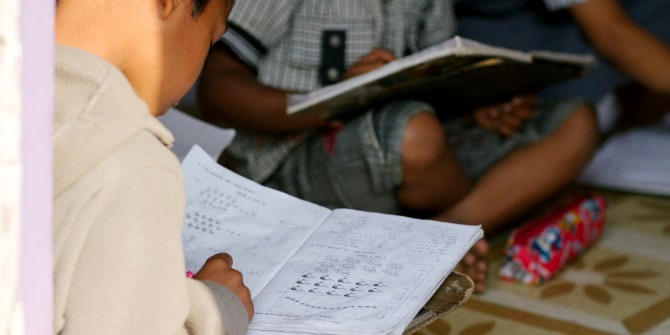In an interview with LSE alumna Hemal Shah, Dr Farzana Afridi analyses Indian women’s access to education and the labour market and stresses the importance of changing cultural stereotypes for genuine empowerment.
When it comes to evaluating the third Millennium Development Goal of promoting gender equality and empowering women in the Indian context, many things come to mind: India’s patriarchal society, the culturally ingrained ‘son preference’, Amartya Sen’s ‘missing women,’ and unimpressive sex ratios in education and workforce participation. Although various government policies and programmes seek to improve gender parity, India’s cultural discrimination against women hampers the process.
LSE alumna Hemal Shah caught up with Dr Farzana Afridi to discuss these issues at the International Growth Centre’s Growth Week 2012. Drawing on her research in development economics, education, and gender, and extensive experience with field experiments and programme evaluation, Dr Afridi analyses Indian women’s access to education and the labour market and stresses the importance of changing cultural stereotypes for genuine empowerment.
Q. What impact do you think the new Right to Education (RTE) Act will have on female enrolment rates?
A. I think the RTE will increase access to schooling of the disadvantaged sections of Indian society—since it loosens the [financial] constraints that households face, we can think of it as an implicit subsidy. But I am not certain what the implications would be from a gender aspect. The RTE might influence decisions about the different quality of schooling for girls and boys. Typically, if boys and girls are both enrolled in a school in a household, boys are sent to better quality schools, or private schools, and girls are sent to public schools. But it is possible that with the RTE more households might choose to enrol girls in school or private schools as budget constraints are loosened. But the question has to be studied empirically.
Since the RTE has only been in effect since 2010, one would have to compare the educational outcomes of students born under the RTE and those who completed their schooling prior to the act. We would have to wait for the first cohort which benefitted from RTE to have completed schooling for the act’s effects to pan out. One would also need very detailed data at the household level to see how households are reacting to the act in terms of expenditures on boys versus girls.
Q. Many experiments – providing bicycles, mid-day meals, cash transfers – have been launched to boost female enrolment in schools. Are one or a combination of such policies best suited to the Indian context?
A. The initiatives you mention look at the demand side—that is, what determines household demand for girls’ education? One of the big concerns in this context is the cost of education, and various programmes simply subsidise the cost of girls’ education by providing them with bicycles, school meals, and scholarships. For example, in Bihar, girls get free cycles, while in Delhi, girls who graduate from high school (class 12) receive about Rs.100,000. This addresses the demand side because financial constraints mean that, without help, families send boys to school, but only send girls to school if they have resources available.
But the supply side also matters. Some studies have shown that schools that don’t have separate toilets for girls, specifically toilets for girls who have reached puberty, see big dropouts from primary to secondary schools. Quality of schooling – including infrastructure and access to female teachers – thus makes a difference.
The cultural context is also a factor. Currently, families don’t value girls’ education either because they think girls don’t need it to get married or they reason that if a girl takes up a job, the wages will be low and the few benefits would go to her husband’s family. These perceptions reduce parents’ incentives to invest in their daughters’ education. That’s why recent research sees an impact of providing information to parents about job opportunities for girls.
Overall, I think you need a mix of measures from the demand and supply sides, a responsive labour market, and ways to provide information to parents. You can’t change cultural stereotypes unless you impact the key variables that go into decision-making; parents are making rational decisions based on the constraints they face in the household in terms of returns to investment.
Q. Why is female labour participation in the Indian workforce so low?
A. Female labour force participation in India is pretty dismal—40 per cent in 2009-10, down from 50 per cent in 2004-05 (25-60 age group). National Sample Survey data shows a decline in female labour force participation since 2004, which is surprising because this is a period of tremendous growth and more opportunities in the labour market. Harvard academic Claudia Goldin has theorised that as countries become richer, the labour force participation of women declines before it starts rising again. Culturally, in India, women are discouraged from working, and as a family becomes more prosperous it finds less need to send its women to work. This may explain the decline in female labour force participation during this period. In addition, there is another hypothesis that most of the female labour force participation in India is in response to distress. It is only when households are in distress owing to a macroeconomic shock or an event such as a drought or famine that they send their women out to work.
Of course, the other concern is that there is discrimination in the labour market, but this is not yet well established empirically since women may voluntarily engage in low-wage work compared to men.
Q. Your recent research examines why the risk of inefficiency and corruption is greater under female leadership in villages. Could you share some of your findings?
A. In villages councils headed by women, we found a greater incidence of corruption and mismanagement, specifically of the National Rural Employment Guarantee Act (NREGA) in Andhra Pradesh. But among women who have political or administrative experience, or both, the results are the opposite—we found a decrease in mismanagement, bad governance, and pilferage of funds. This means that the majority of women being elected to council positions are less educated and inexperienced, leading to a higher probability of the programme being hijacked by the local bureaucracy.
These results indicate that policies to increase women’s representation in the political sphere through affirmative action are not sufficient to give women a real voice—it is just tokenism. To enable them to have real power and make a difference at the grassroots, you have to empower them through capacity building and training.
Q. Is NREGA gender inclusive and can it boost female labour participation in the long run?
A. NREGA requires one third of the employed labour to be female. Our research finds that women are participating more than men in NREGA in some parts of the country. NREGA brings work to women’s doorsteps and offers them wages that are at par with what men get. Compared to casual work in the private sector, NREGA boosts gender parity. There is a lot of literature that shows the benefits of providing women access to the labour market: when women earn money, their say in how the money is spent increases. In a recent working paper, I find there is improved educational outcome and increased education expenditure on children, especially on girls, when the share of NREGA workdays for the mother increases in a household in Andhra Pradesh. Even if you yourself are not participating in the programme, the fact that you have options outside of the family empowers you within the family.
Farzana Afridi is Assistant Professor of Economics at the Indian Statistical Institute in Delhi. Her current research interests include female labour force participation, the design of public programmes in developing countries, and the effects of gender on governance.
Hemal Shah is a public policy researcher at the Legatum Institute, a London-based think tank. She completed her Masters in Development Studies from LSE in 2010, and tweets at @hemalshah_7








